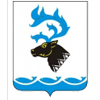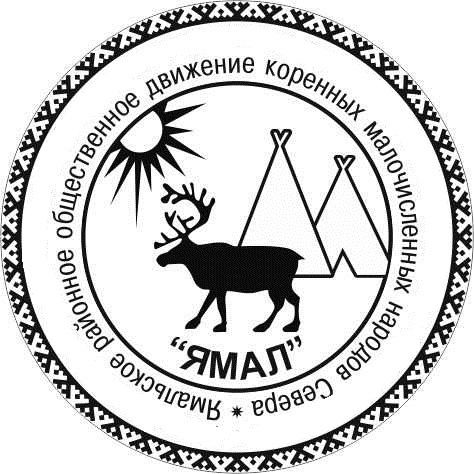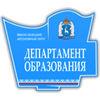On February 21st we had visitors again: Roman came to our chum on his way back to Yar-Sale town. Mikhail Podovitch Hudi (his chum is standing noth or ours) with his daughter Yana and son Vakato were accompanying Roman.
In the night, just after everybody in the chum went to bed, we've heard a sound of an approaching truck. Kostya and Alexander rushed out of the chum. Nearby they saw a cross country truck "Ural". A man said that he was for the first time going from Labytnangy to Bovanenkovo town, he looked like a typical businessman transporting food. He also explained that he stopped at the chum, because he and other drivers shooted partriges and didn't want herders thought that they tried to shoot the reindeers. The stranger asked for reindeer's meat, fish or horns and invited our men to join him for glass of vodka. As they denied his invitation, he left, so Kostya and Alexander went back to bed, wondering about this visit.
On February 2nd we were going to dehorn some bulls from the herd, which started already mew their horns. Reindeer herders try to dehorn animals in time (don't wait for the natural way) to exchange horns for gazoline, food or money. Kostya on his snowmobile collected the herd and suddenly came back with a dead bull. It was a yong and very good riding bull named Yanik (Calm). Its skin was damaged with shotgun pellets in five points. The reindeer was still warm, which meant it died not long ago. Kostya and Albina were both very sad and pity for the riding bull. Who could do that?
As Kostya and Albina say, they spent several years nears in the area near this winter road and nobody would ever shoot their reindeers. There no chums in 20 kms area around us, and anyway no neighbors would do it. We were told that in the Hansky side, near Kutoryugan, where Yar-Sale brigades spend the winter, such precedents could happen. Guilty are usually town or city residents, or drivers, not tundra residents anyway. Before and after our night visitors we had no other car passed by. Having analyzed their behaviour, we remembered their strange wish to "shoot partriges".
We concured that it might be an action of our night visitors. We contacted police in Yar-Sale town. An officer on duty asked Kostya carefully about drivers and their car and promised to call back. He said that the truk would be detained and checked in Bovanenkovo town (we all know exactly it's impossible). A policeman explained to Kostya that to explore the situation he would have to go to the town anyway. It was so strange to hear that - on the one hand it's logical to bear witness, but on the other hand it's impossible for the family to go to the town now, no gazoline for tundra ride of 500 kms for instance. "You are riding something, right? A snowmobile maybe?..." - it's all we've heard. We still don't know how this story will end, but as Kostya saidly jokes, one will send a helicopter to testify a polar bear in tundra, but nobody would care the shot reindeer, and the herder would have to go to the town to witness it.
Yanik:
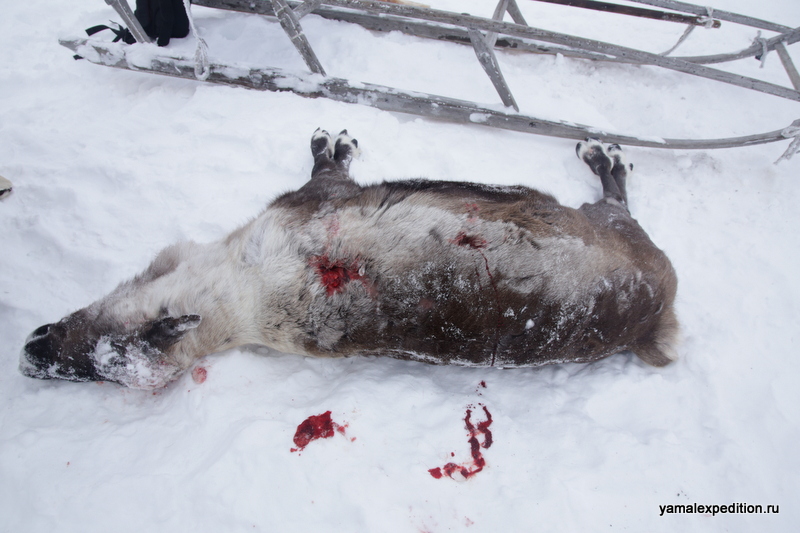
(to continue reading please press "Читать полностью")
February 23-24th:
There was a strong snowstorm two days in a raw. We buit a wind porch to keep warmth in the chum - it's usual in tundra. In front of the entrance one place a trunk-narta with provisions, one make over it a construction of sticks, covered when with canvas sheet or geofabric. Tundra residents call this wind porch a seni. Besides it's convenient to take out of the trunk-narta - no need to go our of the chum during the snowstorm.
During this had (snowstorm) we discussed many interesting topics and watched a lot of movies. Once during the breakfast we discussed linguistic borrowings in the Nenets. Many tundra families use Russian words instead of the Nenets: for example, ложка (spoon) instead of hu, поварешка (ladle) instead of нялько and so on). Finally we discussed numeral adjectives and difficulties with number 9. Ӈопой – one, сидя – two, няхар”– three, тет – four, самляӈг – five, мат”– six, си”ив – seven, сидндет – eight, хасава ю” – nine, ю”– ten. Хасава ю” (hasava yu) can be translated as "male or the Nenets ten". One of the leading researchers of the Nenets culture A.V.Golovnev suggests that traditional Nenets calculating system might be nonary, but in his works there are some linquistic confusion. Modern Nenets give no explanations to the source of the name of "nine". 90 – hasavayur ” (male/Nenets hundred), 900 – hasavayenar” (male/Nenets thousand). Kostya, Albina tought us to pronounce 999 and 9999 and then we repeated it all together. 9999 is a real tongue twister – хасава ю” ёнар” хасаваёнар” хасаваюр” хасава ю” - hasava yu''onar''hasavayonar''hasavayur''hasava yu''.
Semyonko and Pedavako on the warpath:
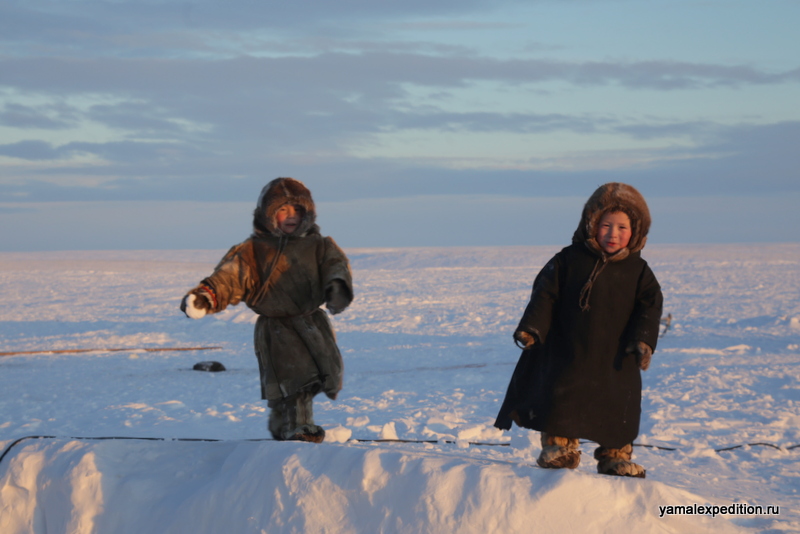
Narta with ice from the lake, these big ice pieces will melt into a lot of water:

A chum still life: paradavy halya – fish fried on the stove, syay'yed – teapot. And Longe the dog (also called Loncha, Lo-Lo, Lolochka).
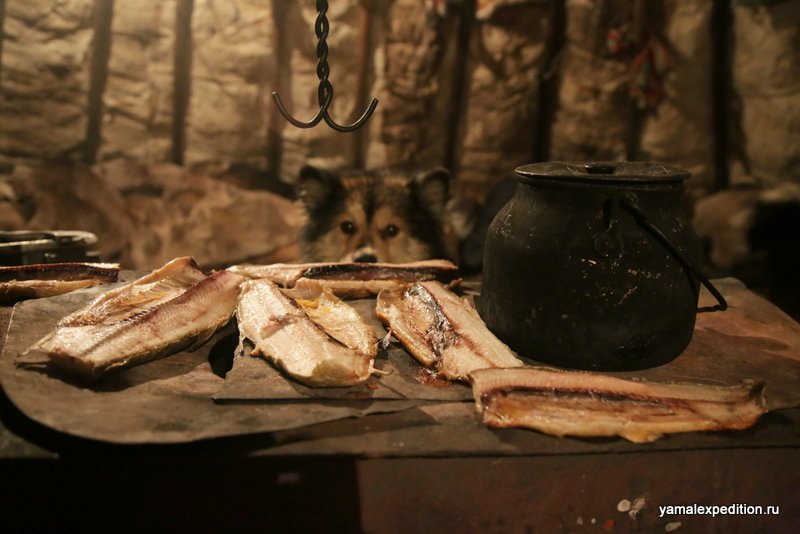
On February 25th Kostya and Alexander went to a sacred place Pongarme''e (Поӈгарме”э, from the Nenets ponga – fishing net) and took there a skull of a shot reindeer. Usually one comes to the place to pray for successful fishing or hunting. During their absence, Zhenya (Panyok) Okotetto and Kostya Hudi stopped at our chum. The "13th district" residents were on their way to Bovanenkovo town.
The weather is better now, soon one have to wear sunglasses.
February 27-28th:
In the morning we removed the snow around the chum, picked and dehorned the riding bulls. Some bulls already started to lose the horns, spring will come soon. Horns are the firmest currency in tundra. In summer reindeer herders cut velvet reindeers filled with blood, and in winter - hardened horns. Herders sell them or exchange on the "floating rate" for food and fuel. This year's price is two time higher than last season because of the dollar's rate rising (or Ruble devaluation) and makes approximately 1000 Rubles/kg. The main Consumer of horn is pharmaceutical industry of China, but as tundra people and some businessman say, even China so not need horns in that abundance - so price must drop soon. The paradox of the situation is as follow: herders who the beginning of winter cut still not hardened horns, could gain more than people waited for spring to provide the quality wares. How much can a herder gain for horns in average? Calculate yourself - from the herd of 250-300 reindeers - not big herd in the scale of Yar-Sale tundra - one can collect 60-80 kgs of horn.
Kostya is going to exchange horns for gazoline - at the trading post, or if somebody brings it from Salekhard. Gazoline price at the trading post is 25-30 kgs for a barrel (200 l), so you can calculate yourself how much herders pay for the fuel.
In the evening a snowstorm began again, and lasted for the whole next day.
On February 29th Albina went to Salekhard by train. Her plan was to buy some provision. Many families try to purchase store of food (spaghetti, butter, tea, grains and condenced milk) for the whole year on the wholesale warehouse. An important factor here is the railway Obskaya-Karskaya, and indigenous population can travel for free (and transport up to 500 kgs luggage). Kostya's parents Mamanka and Nache will join here on the way back to the chum.

